
Updated on: August 29, 2024
Short on time? Here’s how to protect against the Norton PayPal Scam in 2024:
- Install a Quality Antivirus. Pick a good antivirus with excellent malware detection rates, download it, and follow the installation process to get it set up on your device. Norton remains an excellent option despite its namesake being associated with the scam. It comes with a range of extra security features to keep you safe online.
- Run a Full System Scan. Let Norton run a full system scan on your computer or phone. It may take upwards of 1 hour, so give it time and be patient. Once it’s finished, you’ll see a list of all the malware it has detected and an option to remove it. Follow the instructions to remove the malware.
- Use Web Protection. To ensure you stay protected in the future, keep Norton on your device and install quality web protection. This will automatically scan new websites for threats, monitor attachments from emails, and safeguard you from phishing scams.
If you’ve received an email from PayPal about a Norton subscription you didn’t pay for, don’t reply to it, click any links, or phone any numbers on it. It’s a common scam used to steal your info through malware-ridden links, fraudulent phone numbers, and shady attachments. If you think you’re a victim of the Norton PayPal scam, install an antivirus and scan your computer for malware.
Unfortunately, not every antivirus is good enough to help. Most can’t deal with complex threats, and in some cases, shady companies bundle their fake antiviruses with faulty tools, putting you at even more risk.
I tested the most popular antiviruses on the market to find one capable of dealing with the Norton PayPal scam. It was a close competition between several quality suites, but despite the unfortunate association by name, Norton took the top spot thanks to its advanced security features, excellent web protection, and flawless malware scanner. However, it’s important to note that Norton is not affiliated with the scam; rather, its strong security measures are excellent at thwarting such threats. Since it has a 60-day money-back guarantee, you can try it out for yourself risk-free.
How to Detect, Remove & Protect Against Norton PayPal Scams (Step-By-Step Guide)
Step 1. Install Reliable Antivirus Software
First, you need to purchase a quality antivirus. While Norton remains our top recommendation, we understand concerns that may arise due to its namesake being misused in scams. Rest assured, there are plenty of excellent alternatives out there. Once you’ve purchased a subscription, download your antivirus like you would any other application and follow the installation process.

Step 2. Run a Full System Scan
When your antivirus is installed, you need to run a full system scan of your device. Your antivirus will look for any infected files that might be causing pop-ups, slowdowns, redirects, and other symptoms (even those causing the Norton PayPal scam email).
Using Norton as my example, open up the Device Security tab. Click Scans, then Full Scan, and finally confirm your choice. The full scan can take up to an hour, so sit back and let your antivirus do its job.

Once it’s done, you’ll be shown every file that Norton flagged as a threat. Simply click Remove, and voila, your computer is free of viruses. The final step here is to restart your device and run one more scan just to make sure you’re virus-free. Norton’s subsequent scans go much faster, as it skips over files that it previously analyzed and marked as safe.
Beginners should trust their antivirus and simply remove all flagged files, while advanced users may want to check through the quarantined files to ensure none of them were falsely flagged.
Step 3. Use Web Protection Tools
Phishing scams, including the Norton PayPal scam, are the primary methods scammers use to steal your information. To combat them, you need good web protection tools. My favorite antivirus, Norton, offers a free browser extension called Norton Safe Search that works really well. It detected more phishing sites than Chrome and Firefox during my tests.
To install Norton Safe Search on Chrome (it’s also available for Edge and Firefox), you should visit the Chrome Web Store, search for Norton Safe Search Enhanced, and click Add to Chrome. Then, click Add extension in the pop-up window that appears.
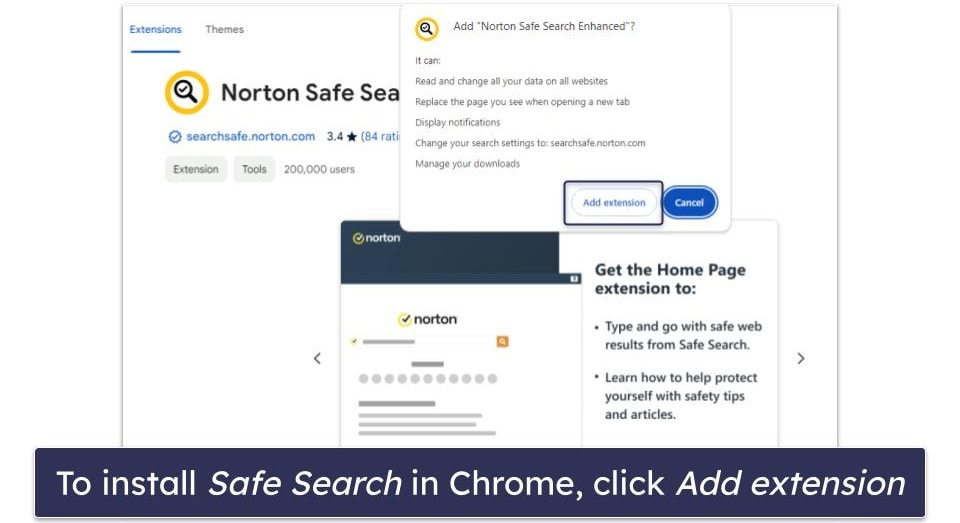
The process is similar in Firefox and Edge: to get the Safe Search extension, you’ll need to visit their respective add-on marketplace.
Apart from Safe Search, Norton also offers a more comprehensive web protection solution, called Norton Safe Web. It’s similar to Safe Search, but it has additional functionalities like online banking protection. Unlike Safe Search, however, this is a paid feature that comes as part of Norton’s premium plans.
Regardless of whether you opted for Safe Search or Safe Web, once you’re done installing it, it’s a good idea to check for suspicious extensions on your default web browser.
Step 4. Uninstall Suspicious Browser Extensions
This step will vary depending on your browser, but it should remain fairly similar. To start, open up your browser’s extension or add-on manager by clicking on the puzzle piece icon (or similar) in the top-right corner of your browser and scroll through your installed extensions. If you find any that you don’t recognize, immediately remove them and perform another full system scan of your device.
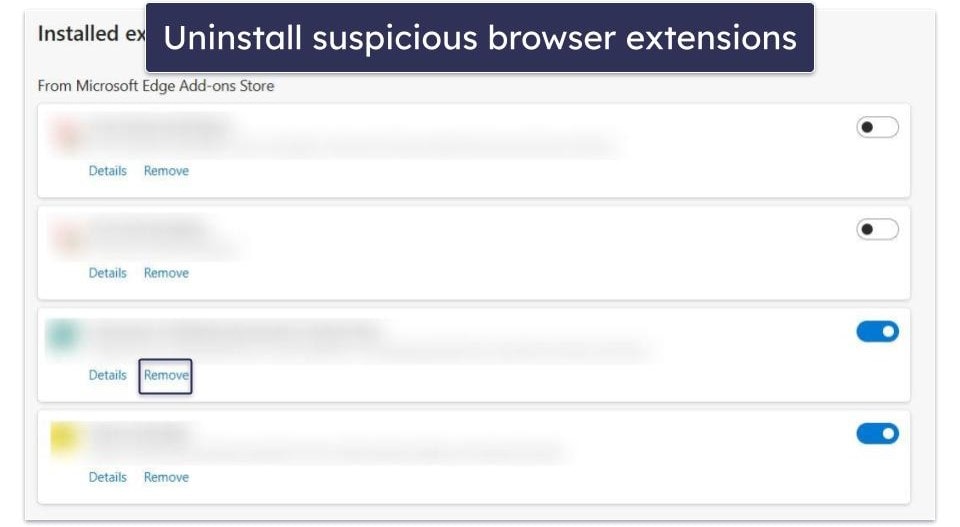
Remember that many “free” browser extensions can secretly be malicious, so stay cautious even after you’ve gotten rid of whatever extension is causing the Norton PayPal scam.
Step 5. Uninstall Shady-Looking Applications
Finally, look through every application you have installed and get rid of any shady-looking apps you don’t recognize. This step will be different depending on your device.
Windows users can utilize their Start button to locate the Control Panel. Alternatively, you can input “Add or remove programs” or “Apps and features” in the toolbar search box.
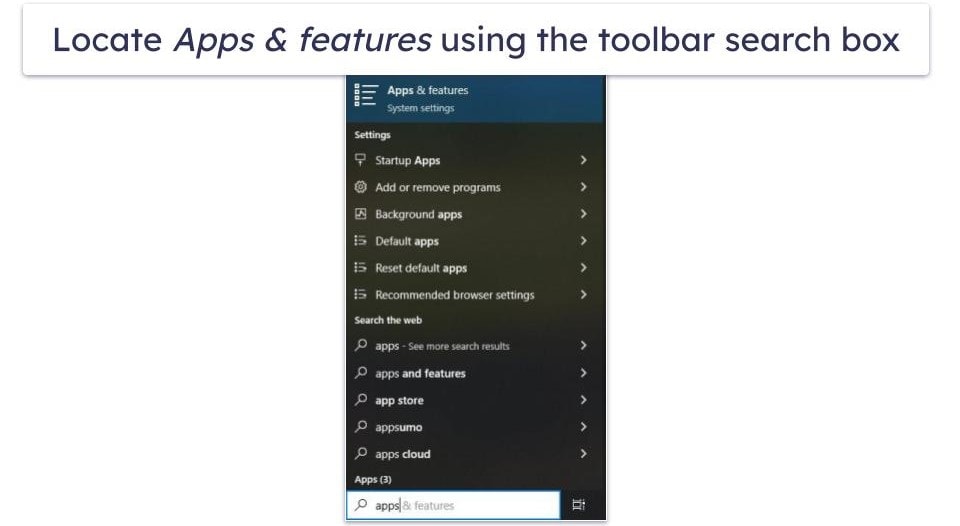
Once there, go through the list of all the programs installed on your computer. Uninstall any that look suspicious to you.
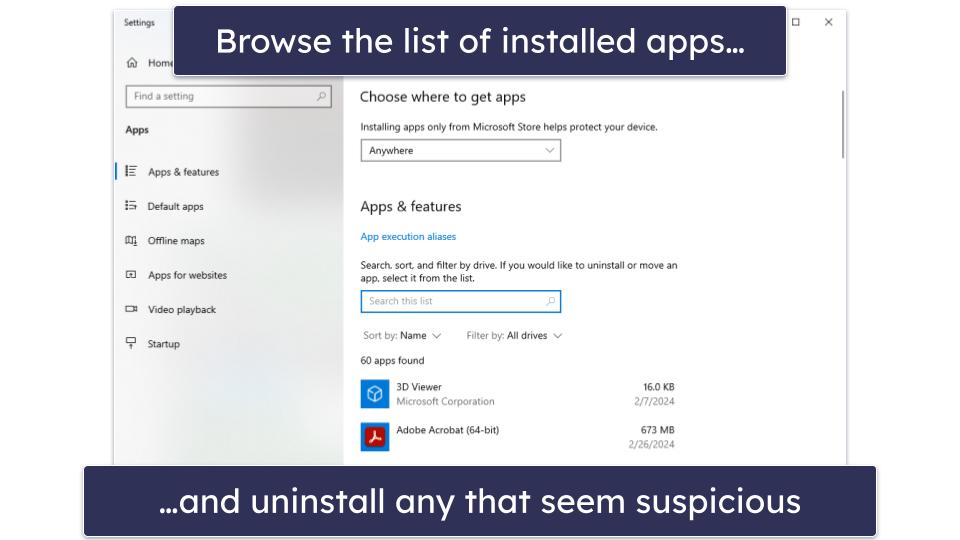
Mac users can employ the Mac’s built-in Finder tool to do the same.
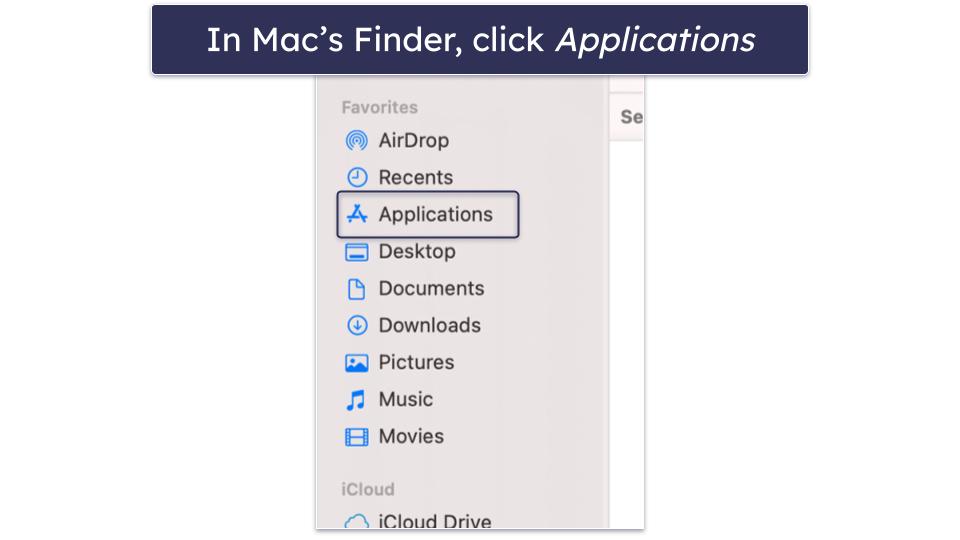
If you’re using a smartphone, scroll through your installed applications and press and hold any you want to remove. Tap Uninstall when the option appears.
Best Antiviruses for Protecting Against Norton PayPal Scams in 2024
Quick summary of the best antiviruses for protecting against Norton PayPal scams:
- 🥇 1. Norton 360 — Best antivirus for protecting against Norton PayPal scams in 2024.
- 🥈 2. Bitdefender — Cloud-based antivirus with plenty of excellent security features.
- 🥉 3. TotalAV — User-friendly antivirus with tools for dealing with PayPal scams.
Common Signs of a Norton PayPal Scam
There are a few telltale signs of a Norton PayPal scam. These are:
- Fake invoices. The most obvious sign is that you’re getting a PayPal invoice for a Norton subscription you never paid for. Don’t panic if you see one — money never left your account; the actor is just trying to trick you into giving them your info or downloading malware. Block the sender and install web protection tools to stay protected.
- Link to a strange website. If the invoice is linking you to a strange website that’s asking for information, immediately close the site. Don’t click on or type anything. Hackers will often take you to third-party websites and entice you to enter your login credentials. If you’re not sure, check the URL and compare it to the official website’s URL. If there are any differences, it’s most likely a scam.
- Grammatical errors. If a seemingly official email is littered with grammatical mistakes, you can safely assume it’s a scam. That said, don’t assume an email without misspellings is automatically legitimate.
- High-pressure tactics. The Norton PayPal scam typically uses high-pressure sales tactics to pressure you into calling their phone number or clicking on their links. If the email is painting a situation with a large sense of urgency, chances are it’s not real.
- Pressure to download an attachment. No legitimate company will try to make you install an email attachment for basic business affairs. If the email features language that frequently pushes you into downloading an attached file, be very careful. Don’t open the attachment and block the sender.
- Unofficial email addresses. Double-check your inbound emails and make sure they’re from official company email accounts, such as @nortonlifelock.com or @identity.norton.com. If an incoming email claims to be from Norton, but the sender’s email address is a string of random letters or has any deviations from the official Norton email, you’re almost certainly looking at a Norton PayPal scam.
What to Do If You’ve Fallen for a Norton PayPal Scam
If you believe you’re a victim of the Norton PayPal scam, don’t panic. Trying to solve the problem on your own can make it worse. No matter how bad the situation currently is, don’t give the scammer any more money or information, no matter what they say. Follow these steps.
- Run a full system scan. Install a reliable antivirus suite like Norton and run a full scan of your computer or phone. Let your antivirus analyze every file on your device and quarantine every threat it finds. Once it’s done, you can remove every trace of malware from your device, including anything installed from a Norton PayPal scam email.
- Download good web protection tools. Web protection tools will monitor every website you visit and alert you if they detect any threats. Norton’s tools will also monitor your emails, alerting you if you attempt to open a suspicious attachment.
- Use a password manager to rotate your credentials. Use the password manager included in Norton or a top standalone password manager to quickly rotate all of your exposed credentials before hackers get a chance to use them (or prevent them from continuing to use them).
- Use a VPN for extra privacy. The top VPNs on the market encrypt your online activity to hide it from hackers, ISPs, and surveillance. It also masks your IP address, increasing your internet security and anonymity.
- Use identity monitoring services. Employ dark web monitoring services to make sure your information isn’t spread online. It’s also worth investing in credit monitoring services to get alerts for any sudden changes to your credit score.
- Enable multi-factor authentication (MFA) on your devices. MFA requires you to authenticate new logins, adding an extra layer of security in case hackers attempt to log into your accounts.
- Contact your financial institutions. Let your banks know you were the victim of a scam so they can monitor your account for you. While you’re at it, replace any compromised credit or debit cards the hacker may have access to.
- Report the scam. Report the scammer to the platform they emailed you on so the company can ban them.
- Keep an eye out for follow-up scams. Once you’ve fallen victim to one scam, you’ll often find yourself the target of a follow-up scam by another threat actor pretending they can help. Keep your eyes peeled for these types of scams, since they can be just as devastating as the initial attack.
How to Protect Against Norton PayPal Scams & Other Email Scams
Protecting yourself in the future requires some vigilance on your end. The best technology in the world can’t stop us from making human errors, so we all must do our part to keep ourselves safe online. To minimize your risk of becoming a victim of another scam:
- Carefully check URLs and email addresses. Make sure that any URL you visit or email you open is actually coming from legitimate sources. For a URL, verify that it matches the official website’s URL. For emails, make sure it matches the official company email account. Norton and
Bitdefender both feature excellent email scanning tools. - Don’t ever click on suspicious links or attachments. The safest thing to do is use your antivirus to scan email attachments before opening them. You should still try to avoid opening anything suspicious, though, just in case. If you do carelessly click on a malware-ridden attachment, it could still cause damage to your device.
- Keep your software and drivers up to date. Out-of-date software and drivers leave you exposed to every vulnerability that’s been patched in the current update. Make sure you have these set to automatically update. Some antivirus programs (like Norton) will help you keep your drivers up to date.
- Report every scam you see. If scammers are regularly reported, they’ll eventually be taken down, saving future victims. I recommend reporting every scam you see (and always blocking the sender).
Frequently Asked Questions
What are web protection tools?
Web protection tools help protect you from online threats like the Norton PayPal scam. They do this by scanning websites in your search bar before you click on them, comparing them to a massive list of known threats. If it finds a dangerous website, it informs you before you click on it and blocks the website.
Some companies also have unique secure web browser apps. You can use them to surf the web like you would on Google Chrome or Edge, but with Norton’s security and privacy protection features built into the browser.
Which antivirus has the best web protection tools?
In my opinion, Norton has the best web protection tools of any antivirus. The web protection extension outperformed Chrome in all of my tests and is more than capable of detecting any websites hosting the Norton PayPal scam. It also features excellent inbound email protection and will scan attachments and links for you to make sure they’re safe.
In addition, Norton’s secure web browser is the best in the industry. On top of detecting and flagging malicious sites more accurately than Chrome or Edge, it also blocks ads and trackers for you.
While Norton is my favorite, there are plenty of excellent internet security suites that offer quality web protection tools that can safeguard you against the Norton PayPal scam.
Are free scanners good enough?
Frankly, no. Free malware scanners aren’t usually as powerful as their premium counterparts and will struggle to detect complex malware. Even if a free antivirus has a decent malware scanner, it will usually lack vital features like real-time protection. The worst of the worst free scanners can even be harmful to your computer or contain their own hidden threats.
A premium antivirus suite like Norton or Bitdefender may require an initial investment, but unlike a free scanner, they’re guaranteed to destroy any malware related to the Norton PayPal scam. Plus, you can rest assured that the real-time protection you invested in will keep you safe in the future.
What can happen if I’ve fallen victim to a Norton PayPal scam?
The answer depends on how you react. If you use a dependable antivirus to scrub your machine of malware, a password manager to rotate all of your credentials, and some basic identity monitoring tools, chances are you’ll be safe.
But if you leave the problem alone, you could have your financial information stolen or become a victim of further attacks. Norton PayPal scammers often trick victims into installing malware on their devices through malicious links or attachments. If a hacker gains full control over your computer, they may encrypt your data and ransom it, attempting to extort more money from you.
If you think you’ve been affected by a Norton PayPal scan, you should immediately install an antivirus program and check for malware.